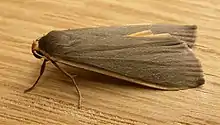Palaeosia
Palaeosia is a monotypic moth genus in the family Erebidae erected by George Hampson in 1900. Its only species, Palaeosia bicosta, the two-ribbed arctiid or two-ribbed footman, was first described by Francis Walker in 1854. It is found in south-eastern Australia.[1]
| Palaeosia | |
|---|---|
 | |
| In Australia | |
| Scientific classification | |
| Domain: | Eukaryota |
| Kingdom: | Animalia |
| Phylum: | Arthropoda |
| Class: | Insecta |
| Order: | Lepidoptera |
| Superfamily: | Noctuoidea |
| Family: | Erebidae |
| Subfamily: | Arctiinae |
| Genus: | Palaeosia Hampson, 1900 |
| Species: | P. bicosta |
| Binomial name | |
| Palaeosia bicosta Walker, 1854 | |
| Synonyms | |
| |
The wingspan is about 30 mm.
The larvae feed on lichen.[2]
Former species
- Palaeosia longistriga, now Oeonosia longistriga (Bethune-Baker, 1908)
References
- Savela, Markku. "Palaeosia Hampson, 1900". Lepidoptera and Some Other Life Forms. Retrieved October 11, 2019.
- Herbison-Evans, Don & Crossley, Stella (13 May 2018). "Palaeosia bicosta (Walker, 1854) Two-ribbed Footman". Australian Caterpillars and their Butterflies and Moths. Retrieved 11 October 2019.
- Pitkin, Brian & Jenkins, Paul. "Search results Family: Arctiidae". Butterflies and Moths of the World. Natural History Museum, London.
This article is issued from Wikipedia. The text is licensed under Creative Commons - Attribution - Sharealike. Additional terms may apply for the media files.